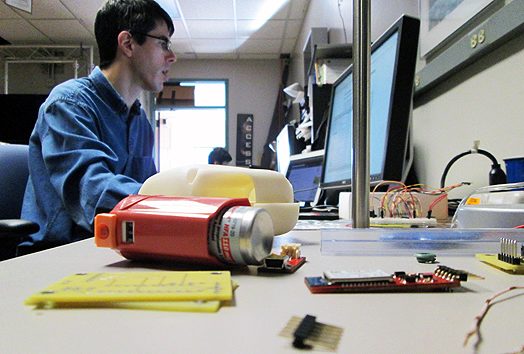Treating asthma? There’s an app for that
November 15th, 2012
Categories: Applications, Devices, User Groups, Virtual Medicine

About
EDITOR’S NOTE: In Fall 2011, the UIC Electronic Visualization Laboratory received a pilot grant for “Human Augmentics for Sustained Wellbeing” from the UIC Center for Clinical and Translational Science (CCTS), award CCTS-0512-07. The award, to computer science professors Jason Leigh and Robert Kenyon, communications professor Steve Jones, and psychology professor Stellan Ohlsson, in partnership with Giselle Mosnaim of Rush University Medical Center, focuses on the proper use of daily asthma controller medications in urban high-risk adolescents. More generally, the pilot study illustrates how the availability of a compelling “health dashboard” smartphone application may inform and persuade individuals to lead healthier lifestyles.
This project is now the subject of a recent news article. Excerpts appear below. Read the entire article
Treating asthma? There’s an app for that
by Mitch Smith, Medill Reports Chicago
November 14, 2012
Sure, teens would rather play basketball or check their cell phones than even think about their asthma medicine.
But researchers hope a new sports-themed cell phone app will encourage asthmatic kids to use their inhalers and allow doctors to more closely monitor their patients.
Rush University Medical Center plans to begin testing the app this winter, making it available free to 10 pre-selected African Americans ages 11 to 16 from the Chicago area.
Black children have higher rates of asthma than their white counterparts, said Dr. Giselle Mosnaim, a Rush University researcher leading the app user study. African American kids with asthma are also less likely to take their medicine and more likely to visit the emergency room than their white peers, Mosnaim said.
But Mosnaim said she believes those risks can be reduced by interceding during an asthma patient’s formative years.
“Adolescence is the time when people develop lifelong health habits,” she said. “If you can intervene in adolescence, then hopefully you can make a change that can last them through the rest of your life. I can’t change whether you have asthma or not, but I can change the outcome.”
Here’s how it works: When youths in the study use their inhalers, the time of their dose is relayed to a cell phone app being designed by graduate students at the University of Illinois at Chicago’s Electronic Visualization Laboratory.
That app allows the kids to track their own progress and lets doctors see, in real-time, when patients are using their inhalers and how much of a dose they’re taking. It gives the patients a reminder if they’re due for another puff.
The app is also designed to be fun. It allows boys and girls to create an avatar - with customizable faces, mustaches, glasses and other features - and shoot a virtual basketball each time they use an inhaler.
“The idea is to show them something and to make the app represent their progress,” said Brent Grossman, a UIC master’s student working on the project.
“The goal is, at the end, they get so used to taking their doses that they don’t need the game,” Kenyon said.
Learn more about UIC’s focus in Human Augmentics.
Learn more about the Human Augmentics class held Spring 2012.
Read a news article about the class, titled “Chicago virtual reality lab home to futuristic health class”.
Learn about our funded pilot study, click on the following link and scroll down to “Human Augmentics for Sustained Wellness”.